
Dordura is a monotypic moth genus of the family Noctuidae erected by Frederic Moore in 1882. Its only species, Dordura aliena, was first described by Francis Walker in 1865. It is found in the Indian subregion, Sri Lanka, Myanmar, Thailand, Peninsular Malaysia, Sumatra, Borneo and New Guinea.

Hulodes caranea is a species of moth of the family Erebidae first described by Pieter Cramer in 1780. It is found from India, Sri Lanka, Myanmar, Java, Hong Kong to Queensland and New Guinea, it is also found on the Marianas and Carolines.

Mythimna decisissima is a moth of the family Noctuidae first described by Francis Walker in 1856. It is found from India across south-east Asia including Hong Kong, Japan, Taiwan and Australia in Queensland and New South Wales. It is also present in South Africa.
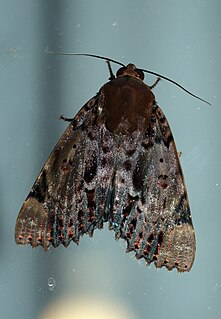
Arcte coerula, the ramie moth, is a moth of the family Noctuidae. The species was first described by Achille Guenée in 1852. It is found from in south-east Asia, including Fiji, India, Sri Lanka, Myanmar, Japan, New Guinea, Taiwan and Norfolk Island. It has been recently observed in Hawaii, on the island of Maui.

Thyas coronata is a species of moth of the family Noctuidae first described by Johan Christian Fabricius in 1775. It is found from the Indo-Australian tropics of southern China, Taiwan, Japan, Nepal, India, Sri Lanka to Micronesia and the Society Islands.
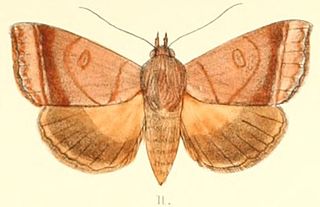
Ophiusa trapezium is a moth of the family Erebidae first described by Achille Guenée in 1852. It is found from the Indo-Australian tropics of India, Sri Lanka to Queensland, the Bismarck Islands and New Caledonia. Adults are fruit piercers.
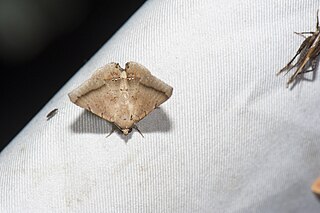
Macaldenia palumba is a moth of the family Noctuidae first described by Achille Guenée in 1852. It is found from the Oriental region of India, Sri Lanka to Japan (Okinawa) and Sundaland, east to New Guinea. It is also found on Guam in Micronesia.
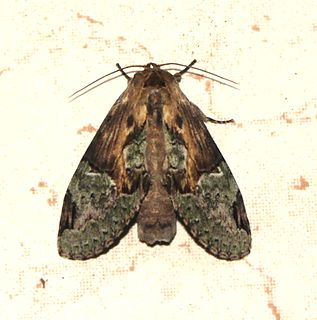
Chadisra bipars is a moth of the family Notodontidae. It was described by Francis Walker in 1862 and is found in the Indomalayan realm.

Eucyclodes gavissima, the Oriental orange banded green geometer moth, is a species of moth of the family Geometridae described by Francis Walker in 1861. It is found in the Indian subregion, Sri Lanka, Bhutan, western China, Taiwan, Sumatra and Borneo.

Sympis rufibasis is a moth of the family Noctuidae first described by Achille Guenée in 1852. It is found from the Indo-Australian tropics of India, Sri Lanka, Borneo east to New Guinea, the Solomons and Queensland.

Serrodes campana is a species of moth of the family Erebidae first described by Achille Guenée in 1852. It is found from the Indo-Australian tropics to eastern Australia, Fiji, Samoa and New Caledonia. It is also present in Japan, Korea and Sri Lanka. The adult is a fruit piercer, but also feeds on flower nectar.
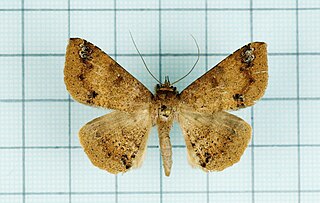
Ericeia inangulata, the sober tabby, is a moth in the family Erebidae. The species was first described by Achille Guenée in 1852. It is found in the Indo-Australian tropics of China, India, Sri Lanka, Myanmar, and the Marianas and Carolines, Fiji, Vanuatu, New Caledonia and Samoa.

Maliattha signifera is a species of moth of the family Noctuidae first described by Francis Walker in 1858. It is found in south-east Asia, including China, India, Japan, Taiwan, Korea and Thailand as well as in Australia (Queensland).

Hyperythra lutea is a moth in the family Geometridae. The species was first described by Caspar Stoll in 1781. It is found in Indian subregion, Sri Lanka, South East Asia, Sundaland.
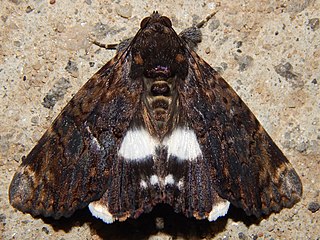
Nagia linteola is a species of moth in the family Erebidae first described by Achille Guenée in 1852. This species occurs in South Africa, the Democratic Republic of the Congo, Yemen, the Comoros, Mauritius, Madagascar, Indonesia (Borneo), India, Sri Lanka, Myanmar, Thailand and in Australia, where it has been recorded from Western Australia, the Northern Territory, Queensland and Victoria.

Isturgia catalaunaria is a moth of the family Geometridae first described by Achille Guenée in 1858.
Sauris hirudinata is a moth of the family Geometridae. It was described by Achille Guenée in 1858. It is found in Fiji, Sri Lanka, India, Hong Kong, as well as on Peninsular Malaysia and Borneo.

Hypopyra vespertilio is a moth of the family Erebidae first described by Johan Christian Fabricius in 1787. It is found in China, Korea, Honshu in Japan, India, Sri Lanka, Nepal, Thailand, Myanmar, Cambodia, Vietnam, Taiwan, Malaysia, the Philippines, Java, Sumatra and Sulawesi.
Sufetula rectifascialis is a moth in the family Crambidae. It was described by George Hampson in 1896. It is found in Sri Lanka.
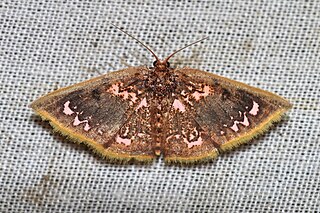
Chrysocraspeda abhadraca is a species of moth in the family Geometridae described by Francis Walker in 1861. It is found in Indian subregion including India and Sri Lanka, Peninsular Malaysia, Sumatra and Borneo.
















